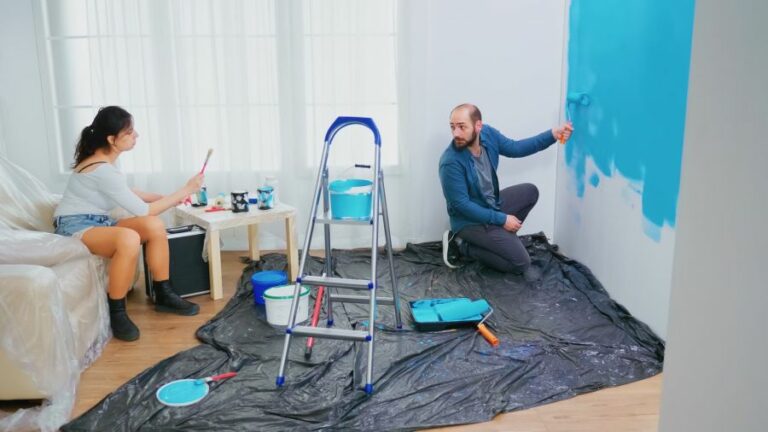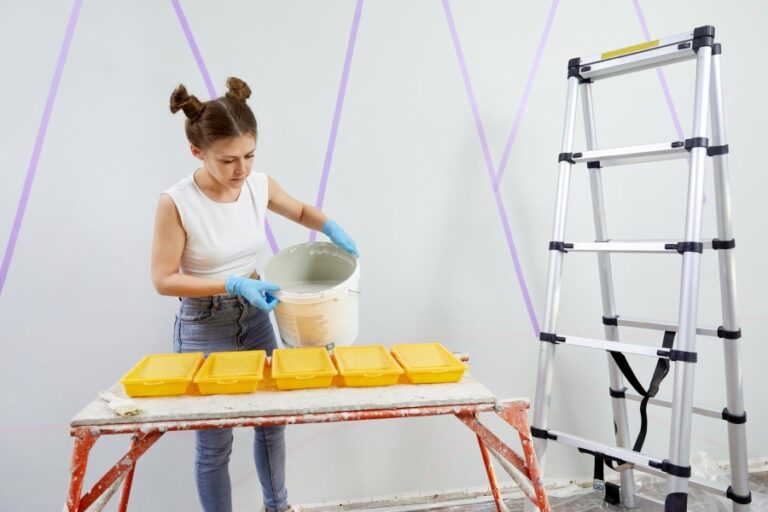Indoor Painting Tips For Beginners, 25 Things You Should Know
Embarking on a new painting project can be both exciting and intimidating for beginners, but worry not! I’m here to guide you through the process, making it as simple and enjoyable as possible. With these indoor painting tips, you’ll have all the knowledge and confidence you need to transform your space into a work of art.
Indoor painting tips for beginners:
Indoor painting tips for beginners include choosing the right paint finish and quality, using a primer if necessary, gathering essential supplies, preparing the room, applying primer, cutting in with a brush, using a paint roller for even coverage, applying multiple coats, and cleaning up after the project. Proper preparation and technique can yield a professional result, even for first-time painters.

Ready to transform your space with a fresh coat of paint? We have a treasure trove of tips for beginners to help you achieve professional results, avoid common mistakes, and navigate your indoor painting journey with confidence. Read on to unleash your inner artist!
Contents
- 1 Beginner’s Guide to Interior Painting Techniques
- 2 Proper Sequence for Painting a Room: A Guide
- 3 Simplifying Indoor Painting: Tips and Tricks
- 4 Common Room Painting Mistakes to Avoid
- 5 Step-by-Step Guide to Painting a Room for Novices
Beginner’s Guide to Interior Painting Techniques
Painting the interior of your home might seem like a daunting task, but with the right tips, tools, and techniques, it can be an enjoyable and rewarding experience.
• Choosing the Right Paint
The first step in any painting project is choosing the right paint for the job. There are various types of paint, each with its specific properties and purposes. When selecting paint, consider the following aspects:
– Finish
There are several types of paint finishes, including matte, eggshell, satin, semi-gloss, and high-gloss. These finishes typically refer to the paint’s sheen or the amount of light it reflects.
For most interior walls, Consumer Reports recommends a satin or eggshell finish due to their durability and soft sheen that can hide small imperfections.
– Quality
Higher-quality paints generally have better coverage, durability, and ease of application. Investing in good-quality paint can save you time and effort in the long run, as cheaper paints may require multiple coats to achieve an even finish.
– Primer
Primer is a preparatory coat applied to surfaces before painting, promoting better adhesion and durability of the paint.
For previously painted surfaces in good condition, a self-priming paint might suffice; however, if the wall has stains or has never been painted before, consider using a separate primer to ensure a smooth, long-lasting finish.
• Gather the Necessary Supplies
Before you begin painting, gather all the essential tools and materials to make the process smoother and more efficient. Some items you will need include:
- Paintbrushes (synthetic brushes for water-based paint, natural bristles for oil-based paint)
- Paint roller, tray, and extension pole
- Drop cloths or plastic sheeting
- Painter’s tape
- Sandpaper or sanding block
- Screwdriver and utility knife
- Ladder or step stool
- Bucket and cleaning materials
• Prepare the Room
Preparing the room properly is crucial to achieving a professional-looking paint job. Follow these steps to prepare your space for painting:
– Clear the Space
Remove all furniture, wall decorations, switch plates, and outlet covers from the space. If you cannot remove large furniture pieces, move them to the center of the room and cover them with drop cloths or plastic sheeting.
– Protect the Floors
Cover the floors with drop cloths or plastic sheeting to protect them from paint splatters and spills. Make sure to tape the edges securely to prevent tripping.
– Repair and Clean Walls
Inspect the walls for any cracks, holes, or imperfections that need repairing. For small repairs, use a lightweight spackling compound and a putty knife. Sand the patched areas smoothly once the compound is dry.
After repairs, clean the walls with a mild detergent solution, focusing on areas with grease or dirt buildup. Allow the walls to dry before moving on to the next step.
– Apply Painter’s Tape
Apply painter’s tape along baseboards, door and window trim, and any other area you wish to protect from paint. Press the tape down firmly to ensure a clean edge and prevent paint from seeping underneath.
• Apply the Primer
Applying primer to all the surfaces you intend to paint will provide a uniform base for your topcoat, ensure better adhesion, and help the paint wear more evenly.
Use a brush to cut in around trim and in corners, then use a roller for the larger areas. Allow the primer to dry thoroughly according to the manufacturer’s instructions.
• Start Painting
Now that your space is prepared, it’s time to start painting. Follow these steps for a smooth, even finish:
– Cut In
Using a brush, paint around the room’s perimeter, including areas near trim, windows, doors, and corners in which a roller would not fit. This process called cutting in, helps to ensure clean edges and a more professional look.
– Use a Paint Roller
Dip the roller into the paint tray, fully covering the roller cover with paint. Start at the top of the wall, making a zigzag pattern to spread the paint evenly.
Once the wall section is covered, go back over the area with straight, vertical strokes to ensure an even application. Continue this process, working in sections until the entire wall is painted.
– Apply Multiple Coats
For the most professional, even results, it is often necessary to apply multiple coats of paint. Allow each coat to dry completely before applying the next one, per the manufacturer’s instructions. In most cases, two coats should suffice.
• Clean Up and Enjoy
Once the final coat of paint is dry, carefully remove the painter’s tape, revealing clean, crisp edges. Reinstall all switch plates and outlet covers and return your furniture and decorations to their original positions. Clean your brushes and rollers thoroughly for future use or dispose of them properly.
By following these indoor painting tips for beginners, you can transform your space and create a fresh, new look. With a little practice and patience, you’ll have the skills necessary to tackle any painting project with confidence.
Proper Sequence for Painting a Room: A Guide
When it comes to painting a room, knowing the correct order to follow is essential for achieving professional-looking results.
• Step 1: Preparation
– Clear the Room
Before starting, make sure to remove all furniture and objects from the room. If not possible, move them to the center of the space and cover them with drop cloths or plastic sheeting.
– Clean Surfaces
Next, clean all surfaces (walls, trim, and ceilings) to remove any dirt, dust, or grease. Washing with a mild detergent and water is enough. Allow surfaces to dry thoroughly before moving on.
– Protect Floors and Trim
Use non-slip drop cloths to cover the entire floor. Apply painter’s tape along the edge of baseboards, window frames, and door frames to protect them from paint splatters and ensure clean lines.
• Step 2: Apply Primer
A primer is an essential step, as it aids in paint adhesion and helps mask any existing stains or color variations. Be sure to choose a primer compatible with your paint type (oil-based or water-based).
– Prime the Ceiling
Start with the ceiling. Use a paint roller with an extension pole to reach this area easily. We recommend working in small sections and using a zigzag pattern for even coverage. Allow the primer to dry as per the manufacturer’s instructions.
– Prime the Walls
Next, prime the walls. Cut in along the edges with a paintbrush, then use a roller for the remaining surface. Refer to the manufacturer’s instructions for the drying time.
Here’s a helpful resource on primer selection provided by the Purdue University Extension.
• Step 3: Paint the Ceiling
Choose high-quality ceiling paint for this step. These paints are typically thicker and formulated to minimize splatters and drips.
- Stir the paint before using it, and pour a sufficient amount into a paint tray.
- Use a paintbrush to cut in along the edges.
- With a roller, apply paint in a zigzag pattern, working in small sections to ensure even coverage.
- If a second coat is required, allow the first coat to dry according to the manufacturer’s instructions before proceeding.
• Step 4: Paint the Walls
Select a durable wall paint in the desired finish (matte, eggshell, satin, semi-gloss, or high-gloss).
- Pour the paint into a tray and thoroughly stir it.
- Use a paintbrush to cut in along the edges, around doors and windows, and along the baseboards.
- With a roller, apply paint using a “W” or “M” pattern. This ensures even coverage and minimizes streaks.
- Apply additional coats, if necessary, allowing sufficient drying time between each coat.
• Step 5: Paint the Trim
Wait for the walls to be fully dry before moving on to the trim (baseboards, door frames, and window frames).
- Choose a paint appropriate for the trim material (wood, metal, or composite) and in the desired finish (usually semi-gloss or high-gloss).
- Use a high-quality, angled paintbrush for precise application.
- Start by painting baseboards, then move on to door and window frames.
- Apply multiple coats, if needed, allowing each to dry as per the manufacturer’s instructions.
• Step 6: Final Touches
Once all paint is dry, it’s time for some final touches.
- Carefully remove the painter’s tape, pulling it back on itself at a 45-degree angle to avoid damaging the paint.
- Discard drop cloths and inspect the surfaces for any missed spots or touch-ups needed.
- Once any necessary touch-ups are complete, reinstall any wall fixtures or switch plates.
- Finally, move the furniture back into the room and enjoy your freshly painted space!
By following this expert guide and the proper order when painting a room, you’ll achieve a professional-looking finish that will stand the test of time. Happy painting!
Simplifying Indoor Painting: Tips and Tricks
Painting the interior of your home can be a daunting task, but with proper preparation and the right techniques, it doesn’t have to be.
• Choose the Right Paint and Tools
Before you begin your painting project, it’s essential to choose the right paint and tools for the job. Some considerations include the following:
– Selecting the Right Paint
- Finish: Choose a finish that suits your needs. Matte finishes are best for low-traffic areas, while satin or semi-gloss finishes are more durable for high-traffic areas.
- Color: Consider the room’s purpose, size, and natural light when selecting a color. Lighter shades can make a room feel larger and more inviting.
- Quality: Opt for high-quality paint, as it tends to be more durable and easier to work with.
– Gather Essential Tools
- Brushes: Use high-quality brushes in various sizes. A 2-3 inch angled brush is ideal for cutting in and detail work, while a 3-4 inch flat brush can help cover larger surfaces.
- Rollers: Select a 9-inch roller with a 3/8-inch nap for most interior surfaces. Rollers with longer naps may be necessary for textured surfaces.
- Painter’s Tape: Invest in quality painter’s tape to ensure clean lines and protect surfaces from drips and splatters.
For a comprehensive guide on choosing the right paint for your project, visit the Paint Quality Institute’s website.
• Prepare the Room
Proper preparation is crucial for a successful painting project. Follow these steps to ensure the room is ready for painting:
– Remove Furniture and Cover the Floor
- Clear the room of furniture and decor to create a spacious workspace.
- Cover the floor with a drop cloth or plastic sheeting to protect it from spills and drips.
– Clean and Repair the Walls
- Gently clean the walls with a damp cloth or sponge, removing any dirt, dust, or greasy spots.
- Fill nail holes, cracks, and dents with spackling compound or wood filler.
- Repair any damaged or cracked areas with joint compound or caulk.
- Allow all repairs to dry thoroughly, then sand them smooth.
– Apply Painter’s Tape
- Apply painter’s tape along the edges of trim, molding, and any surfaces you do not wish to paint.
- Press down firmly on the edges of the tape to create a tight seal and prevent paint from seeping underneath.
• Painting Techniques for a Professional Finish
Using the proper techniques can greatly improve the outcome of your painting project. Here are a few expert tips for achieving a professional finish:
– Cutting In
- Start in the corner of the room, carefully painting around the edges with a 2-3 inch angled brush.
- Maintain a steady hand, using the brush’s edge to create a smooth, clean line.
- Allow the cut-in paint to dry slightly before using a roller to paint the rest of the wall to avoid lap marks.
– Rolling
- Dip your roller into the paint tray, ensuring the entire surface of the roller is covered.
- Begin rolling the paint onto the wall in a “W” or “M” pattern, spreading the paint evenly and covering a 3-4 foot area.
- Refill the roller as necessary and continue painting until the entire wall is covered.
– Avoiding Lap Marks
- Work quickly to maintain a wet edge, avoiding any areas where the paint has begun to dry.
- Blend adjacent areas by gently rolling over them with a lightly loaded roller.
– Proper Drying Time
- Allow the first coat of paint to dry thoroughly before applying additional coats.
- Drying times can vary based on factors such as humidity, temperature, and the type of paint used. Consult the paint can for specific drying instructions.
• Clean Up and Final Touches
Once your painting project is complete, follow these steps for a polished and professional finish:
– Remove Painter’s Tape
- Carefully remove the painter’s tape, pulling it back on itself at a 45-degree angle.
- For stubborn sections, a sharp utility knife can help score the edge of the paint and prevent tearing.
– Touch Up Details
- Use a small brush to apply any necessary touch-ups or address minor imperfections.
- Allow all touch-up paint to dry thoroughly.
– Replace Fixtures and Hardware
- Reinstall any removed fixtures, such as outlet covers and light switch plates.
- Ensure all hardware is securely fastened and aligned.
With the proper preparation, tools, and techniques, your indoor painting project can be a hassle-free and rewarding experience. Now that you’re equipped with expert advice, it’s time to don your painter’s cap and get to work transforming your space with a fresh coat of paint.
Common Room Painting Mistakes to Avoid
Painting a room can be a fun and rewarding activity, but it can also be frustrating and time-consuming if not done correctly.
• 1. Skipping Proper Preparation
The key to a successful paint job lies in proper preparation. Here are steps you SHOULD NOT skip:
– Neglecting to Clean the Walls
A clean surface is crucial for paint adhesion. Dirt, grime, and dust can prevent the paint from adhering correctly, leading to uneven coverage and poor results. Before painting, use a mild detergent solution to wash the walls and then rinse them with clean water.
Allow the surface to dry completely before moving on to the next step.
– Failing to Remove Loose or Flaking Paint
Loose or flaking paint can cause your new paint job to peel prematurely. Use a paint scraper, putty knife, or wire brush to remove any loose or flaking paint from the surface.
– Ignoring Repairs
Before you begin painting, make sure to repair holes, cracks, and other damage to the walls. Use a spackling compound to fill in small holes and cracks and a joint compound for larger repairs.
For more information on repairing wall surfaces, visit the U.S. Department of Housing and Urban Development’s guide.
• 2. Choosing the Wrong Paint and Tools
Using the right materials and tools is essential for a successful paint job. Here are some mistakes to avoid:
– Using Low-Quality Paint
Using cheap, low-quality paint can result in a poor finish, uneven coverage, and frequent touch-ups. Do your research and choose a high-quality paint that is suitable for your room’s specific needs.
– Not Using Primer
Skipping primer can lead to uneven paint coverage, particularly when covering dark colors or painting on new drywall. Use a primer designed for your wall type and paint to ensure a smooth, even finish.
– Using the Wrong Brushes and Rollers
Selecting the right brush or roller for the job is crucial for a smooth, even application. Choose a high-quality brush for cutting in and a roller with the appropriate nap length for your wall’s texture.
• 3. Poor Painting Techniques
Even with the right prep work and materials, improper painting techniques can lead to subpar results. Here are some painting practices to avoid:
– Oversaturating the Brush or Roller
Dipping your brush or roller too far into the paint or not removing excess paint can cause drips and uneven coverage. Instead, dip your brush about halfway into the paint and gently tap it against the side of the paint can, or use a roller tray to remove excess paint from the roller.
– Painting Without a Plan
Starting to paint with no clear strategy can lead to a patchy paint job. Plan your approach, beginning at one corner of the room and painting in continuous “W” or “M” shaped strokes. Maintain a wet edge to avoid noticeable overlap marks and ensure even coverage.
– Rushing the Process
Applying a second coat of paint before the first coat has dried can lead to uneven color and texture. Allow enough drying time between coats as per the paint manufacturer’s instructions.
• 4. Ignoring Safety Precautions
When painting a room, safety should always be a top priority. Keep these precautions in mind:
– Poor Ventilation
Paint fumes can be harmful if inhaled in large quantities. Ensure proper ventilation by opening windows and using fans to circulate the air.
– Failing to Use Protective Gear
Protect your eyes, skin, and lungs by wearing safety goggles, gloves, and a dust mask or respirator when necessary.
– Not Securing Your Ladder
Ensure your ladder is stable and secure before climbing up to paint high surfaces. Use a sturdy ladder with non-slip feet and have a helper hold the ladder, if possible.
In conclusion, a successful paint job requires proper preparation, the right materials and tools, good painting techniques, and a focus on safety. By avoiding these common pitfalls. You’ll be well on your way to a beautifully painted room.
Step-by-Step Guide to Painting a Room for Novices
• Prepare the Room
Before you begin painting, you need to prepare the room. Remove all the furniture or cover it with plastic. If you cannot move some furniture, push it to the center of the room and cover it. Next, remove electrical outlets and switch plates.
Lastly, cover the floor with drop cloths or plastic to protect it from any paint spills.
– Clean & Repair Walls
To ensure a smooth, professional-looking paint job, inspect the walls for holes, cracks, and other imperfections. Patch any holes using a pre-mixed spackling compound and a putty knife. Sand the patches smoothly when they are completely dry. For more information on repairing walls, visit the U.S.
Department of Energy’s weatherization guide. Remember to wipe down the walls with a damp cloth to remove dust and debris after sanding.
• Choose the Right Paint
Selecting the right paint is crucial to achieving a successful paint job. Decide on the desired sheen (flat, eggshell, satin, semi-gloss, or high-gloss) and choose a quality paint for better coverage and longevity.
– Opt for a Primer
To achieve optimal paint coverage, it is recommended to apply a primer before painting the walls. Primer provides a smooth and uniform surface for the paint to adhere to and can save you time and money by reducing the number of topcoats needed.
• Gather Necessary Supplies
Before beginning your painting project, ensure that you have all the necessary supplies:
- Paintbrushes (1-inch angled brush for cutting in and a 2-inch brush for larger areas)
- Paint roller and roller cover (1/4-inch to 3/8-inch nap for smooth surfaces, and 3/8-inch to 1/2-inch nap for textured surfaces)
- Paint tray and liner
- Extension pole for the paint roller
- Painter’s tape
- Ladder or step stool
- Damp cloth for wiping up mistakes
• Apply Painter’s Tape
To achieve clean, sharp lines, apply painter’s tape along the edges of baseboards, window and door trim, and the ceiling. Press the tape firmly against the surface to prevent paint from seeping underneath.
• Start Painting: Cutting In
Cutting in refers to painting the edges and corners of a room with a brush before using a roller on the larger areas. This technique provides a neat, seamless finish for your paint job. Dip the angled brush about halfway into the paint and tap off any excess.
Hold the brush at a 45-degree angle against the wall, and paint a 2-3 inch wide section along the edges and corners. Work in small sections, moving across the room. If the paint starts to dry before you move on to the next section, use a damp cloth to clean it up before it dries completely.
• Roll On the Paint
After cutting in, use a paint roller to cover the larger areas of the wall. Pour some paint into the tray and load the roller by rolling it back and forth until it is evenly coated. Attach the roller to an extension pole if necessary.
Roll the paint onto the wall in a “W” or “M” pattern, working in approximately 3×3 foot sections. This technique helps distribute the paint evenly and avoids streaks or roller marks.
After completing the “W” or “M” pattern, fill in the remaining area of the section with horizontal or vertical strokes. Continue this process across the wall, ensuring each section slightly overlaps the previous one.
To avoid lap marks, always keep a wet edge and never let your roller become dry. If you notice an uneven texture or missed areas, use a brush to touch up the spots before the paint dries completely.
• Allow the Paint to Dry and Apply Additional Coats
After completing the first coat, allow the paint to dry according to the manufacturer’s recommended drying time. Inspect the room for any missed spots, drips, or uneven areas, and touch up as necessary.
Most paint jobs require a minimum of two coats for even coverage and desired color saturation. Apply additional coats following the same method as the first coat, ensuring you allow adequate drying time between each coat.
• Remove Painter’s Tape and Clean Up
Once the final coat of paint has dried, carefully remove the painter’s tape. If the paint has dried onto the tape, cut along the edge with a utility knife to prevent peeling the paint with the tape.
With the tape removed, reinstall any electrical outlets and switchplates that were removed earlier. Clean paintbrushes and roller cover with warm water and mild soap, and store them for future use. Remove the plastic or drop cloths from the floor and furniture, and return the room to its original state.
Congratulations! You have successfully painted a room. With patience, practice, and attention to detail, beginners can achieve a professional-looking paint job.
Step | Description |
|---|---|
1 | Choose your paint and gather materials: Pick your color and finish, and gather paint, brushes, rollers, drop cloths, painter’s tape, and a ladder if needed. |
2 | Prepare the room: Remove all furniture or cover it with drop cloths, and clean the walls to remove any dust or dirt. |
3 | Tape off trim, outlets, and fixtures: Use painter’s tape to protect any areas you don’t want to get paint on, like trim or electrical outlets. |
4 | Prime the walls (optional): If you’re painting over a dark color or brightening up a room, you may want to apply a coat of primer first. |
5 | Start by cutting in: Use a brush to paint around the edges of the room and any other areas where a roller won’t fit. |
6 | Roll the walls: Use a paint roller to apply an even coat of paint to the rest of the walls. |
7 | Apply a second coat if needed: After the first coat has dried, assess whether you need a second coat for full coverage. |
8 | Clean up and remove tape: Remove painter’s tape and drop cloths, and clean brushes, rollers, and other materials. |
9 | Replace furniture and enjoy: Place furniture back in the room and enjoy your freshly painted space! |







